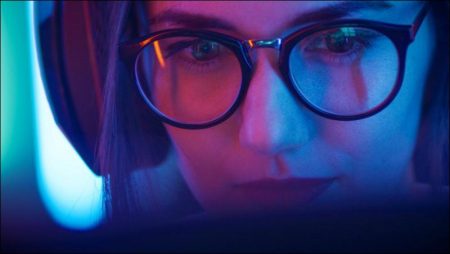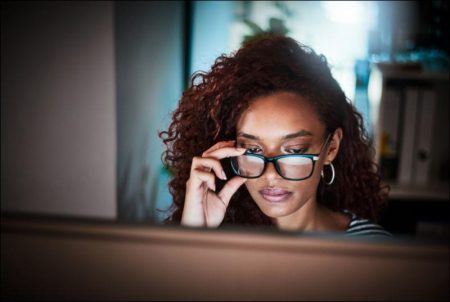Do you ever get a headache after looking at a computer or phone screen for too long? According to the Vision Council, 59 percent of American adults report feeling symptoms of digital eye strain. Blue-light-blocking glasses are becoming increasingly popular, but do they really work — or are they just the latest fashion trend?
As an editor, my days always involve looking at a computer screen for upwards of nine hours a day. I don’t usually wear glasses, but if they can reduce my eye strain and help prevent headaches, then sign me up. It doesn’t hurt that these blue-light-blocking glasses are fashionable too. I decided to put them to the test. But first, what is blue light anyway?
What is blue light?
“It’s emitted from your digital devices, artificial lighting and most prominently from the sun,” Amanda Rights, a doctor of optometry and Transitions brand ambassador, told Yahoo Lifestyle. “The sun is actually the largest source of harmful blue light — emitting more than 100 times the amount of harmful blue light from digital devices. But because we are indoors on our screens for an average of nine hours a day, our devices are negatively affecting us as well. Damage from harmful blue light is thought to be cumulative, similar to exposure to UV light, and may increase the risk of developing skin cancer.
“Excessive blue light exposure has been linked to eye strain, fatigue and headaches and, in the long term, can increase your risk of developing retinal damage,” she added.
“You’ve probably read that excessive exposure to blue light before bed, like working too late or scrolling through Instagram, can impact your ability to fall asleep because it suppresses melatonin — a hormone that helps regulate sleep.”
What are blue-light-blocking glasses?
They are glasses designed with blue-light-blocking lenses that, just as the name implies, block damaging blue light. However, the percentage of blue light they block depends on the glasses. In general, they look and feel like ordinary optical glasses with clear lenses. They come in a variety of fashionable colors, styles and shapes — square, round, oval and cat-eye, and in tortoise, black, clear, red, blue and many more shades.
In the past, I’ve always associated blue-light glasses with those unsightly yellow-tinted versions, but now many brands have launched stylish options alongside their normal eyewear assortment. Direct-to-consumer brands like Warby Parker already offer the option to incorporate blue-light-blocking technology in their lenses (for an extra $50), whereas brands like Diff Eyewear, Quay and Covry offer specific blue-light-blocking glasses.
Do they really work?
I tested my own pairs of blue-light-blocking glasses from Covry and Diff Eyewear over a period of three months. At first, I didn’t notice any immediate differences. However, over time, I did. I would start my day wearing them or put them on toward the late afternoon as soon as I started to sense my eyes getting fatigued or a headache beginning to form. I have to be honest … they worked! I noticed a reduction in overall headaches and eye strain from staring at my computer screen all day.
But it’s hard for me to confirm 100 percent if it’s truly the glasses alone doing the “magic” — is it part placebo effect, or is it a combination of other elements of my day (e.g., staying hydrated, reducing caffeine intake, taking a break, etc.)? Overall, there’s no doubt blue-light-blocking glasses have become especially popular among our team; four or five editors sport them on the reg. Personally, I recommend everyone to try them. They’re not for everyone, but I do feel they helped reduce my headaches and they look super-chic too — a fashionable accessory with function. What’s better than that?
How much do they cost?
They range in price from $15 to upwards of $100. I noticed a considerable difference between the craftsmanship of an under-$20 pair versus a $65-plus pair, but it’s hard to tell the difference in how much blue light they each filter. According to Rights, “It is virtually impossible for the average consumer to spot the difference between a low- and high-quality pair of lenses.
Like most retail experiences, you get what you pay for. Lower-end blue-light-blocking lenses may still be somewhat effective, though they are less durable and do not offer the same warranties as higher-end lenses. In contrast, going to an eye-care provider you trust will ensure you get a quality pair that will fit your lifestyle.”
Visits: 79





